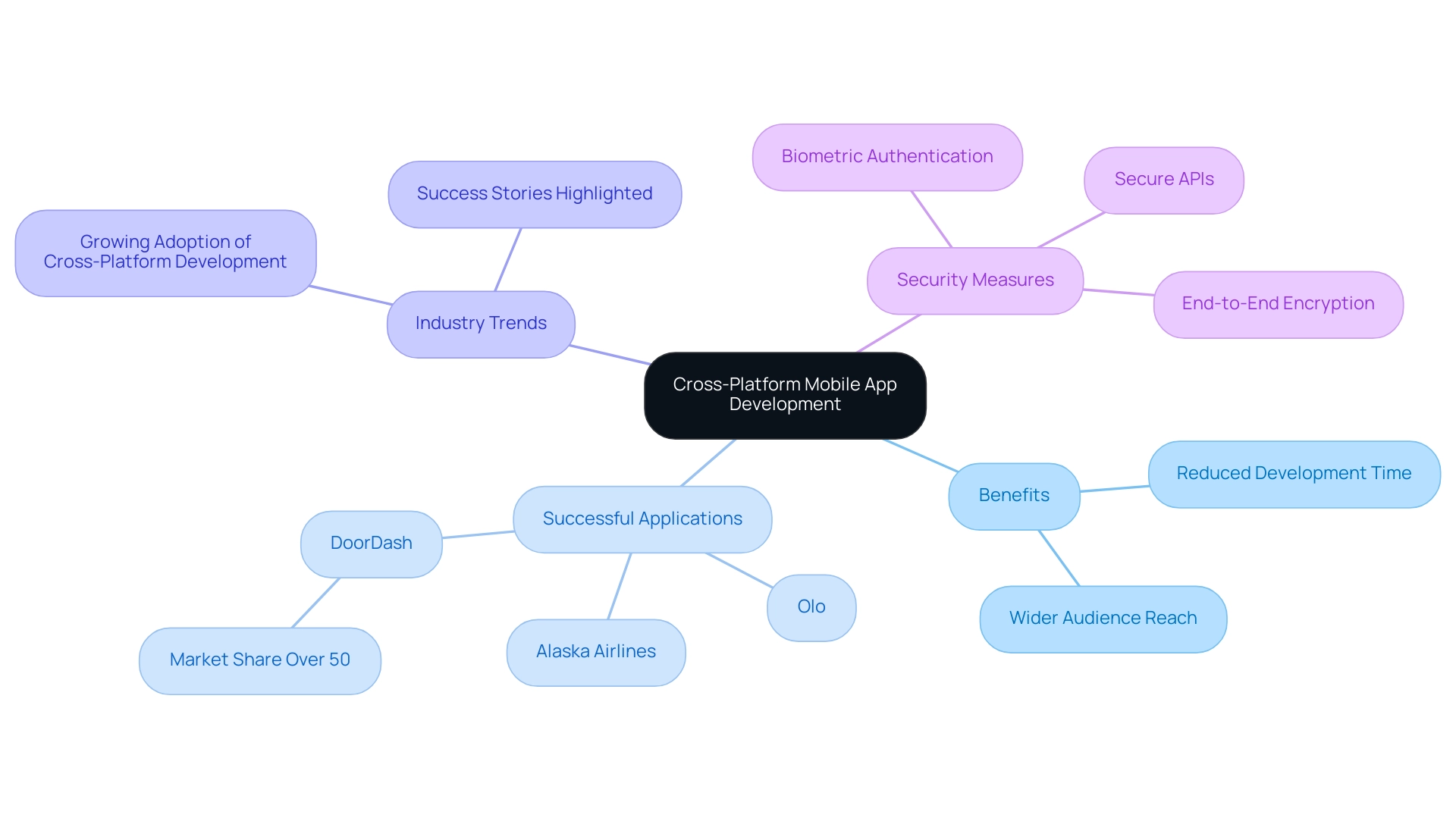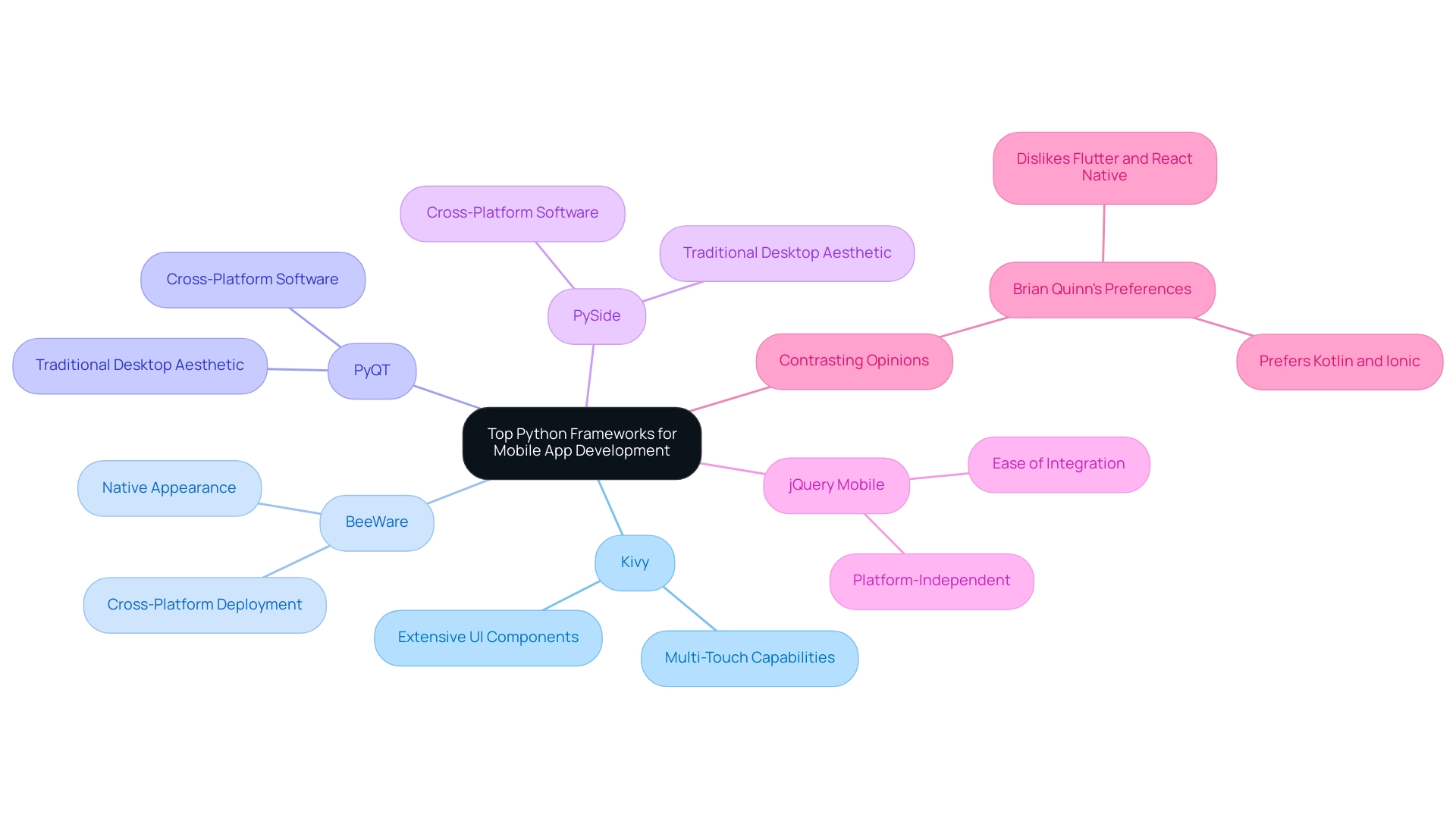Introduction
In the rapidly evolving realm of mobile technology, cross-platform app development stands out as a transformative approach for businesses seeking to maximize their reach and efficiency. By enabling applications to function seamlessly across multiple operating systems, this strategy not only reduces development time and costs but also ensures a consistent user experience.
As 2024 approaches, the momentum behind cross-platform solutions is set to intensify, with successful case studies illustrating their potential to engage users and enhance operational performance. Coupled with the rising popularity of Python in mobile app development, a wealth of frameworks and tools are available to empower developers to create robust applications that meet the demands of today’s digital landscape.
This article delves into the intricacies of cross-platform mobile app development, the advantages of Python, the top frameworks to consider, and the essential steps for bringing a mobile app to life in an increasingly competitive market.
Understanding Cross-Platform Mobile App Development
Cross-platform mobile app development using Python for mobile apps development has emerged as a pivotal strategy for businesses aiming to create software that seamlessly runs on multiple operating systems, including iOS and Android, from a unified codebase. This technique significantly reduces both development time and costs while enabling companies to reach a wider audience efficiently. Utilizing frameworks created for cross-platform functionalities guarantees a consistent experience across different devices, facilitating simpler updates and improvements to software.
In 2024, the trend towards cross-platform development is expected to accelerate, with a growing number of success stories highlighting businesses that have effectively utilized these frameworks. For instance, notable cross-platform applications such as Alaska Airlines and Olo demonstrate successful implementations that enhance engagement and operational efficiency. Moreover, DoorDash, which has captured over 50% of the food delivery market in the United States, underscores how cross-platform apps can drive market dominance by reaching a broader customer base.
Industry experts emphasize the strategic benefits of these frameworks, with one developer stating,
We have purchased the Food Delivery solution for our online food business. It’s needless to say that we are amazingly satisfied with the end result. Thank you, Food Delivery Solution team!
Additionally, as cyber threats evolve, implementing enhanced security measures such as biometric authentication and secure APIs becomes vital for safeguarding data and maintaining trust in portable software. As the demand for portable software continues to surge, adopting a cross-platform approach such as Python for mobile apps development becomes not just beneficial but crucial for enhancing market reach and boosting user engagement.

Why Choose Python for Mobile App Development?
In 2024, Python for mobile apps development has emerged as a preferred choice for application development, owing to its simplicity, readability, and a wealth of extensive libraries. A recent survey of over 60,171 respondents asked developers about the languages they have worked with extensively over the past year and those they wish to continue using, indicating a growing trend among developers favoring Python for its user-friendly syntax, making it accessible for both novices and seasoned professionals alike. This accessibility is coupled with Python’s capability for rapid prototyping, empowering developers to swiftly iterate on designs and functionalities.
Furthermore, Python's versatility is demonstrated through various frameworks that are ideal for python for mobile apps development, enabling the creation of robust software with reduced effort. The vibrant Python community plays a crucial role in enhancing project outcomes, providing developers with ample resources, libraries, and tools to refine their applications. This community support translates to improved app performance and heightened user satisfaction, key factors in today’s competitive digital landscape.
Additionally, the incorporation of Blockchain technology in application development ensures secure transactions and reduces reliance on intermediaries, enhancing security and transparency. As noted by research expert Lionel Sujay Vailshery, the call for innovative, user-friendly apps that address everyday challenges is more pressing than ever:
Get in touch with us now.
With the right approach, Python for mobile apps development can indeed be a game-changer in the field of app development.

Top Python Frameworks for Mobile App Development
In the dynamic landscape of Python for mobile apps development, several frameworks have emerged as frontrunners, each with unique advantages. Kivy, for example, is highly esteemed for its ability to create multi-touch programs, making it an excellent option for interactive and innovative interfaces. It features an extensive array of UI components, allowing developers to create visually attractive software that captivates individuals efficiently.
On the other hand, BeeWare distinguishes itself by enabling developers to create software in Python while deploying them across various platforms, including iOS and Android. Its dedication to maintaining the native appearance and ambiance of software guarantees that individuals enjoy a seamless integration with their operating systems. Additionally, PyQT and PySide are noteworthy for those interested in creating cross-platform software that embodies a more traditional desktop aesthetic.
This method can be especially attractive for developers striving to provide a familiar user interface in applications. However, it's important to consider contrasting opinions in the field. As Brian Quinn states, "I absolutely hate Flutter and React Native.
For the small app development that I do I'll take Kotlin and Ionic. They work and are stable." This highlights a preference for frameworks that offer reliability and stability over newer alternatives.
Furthermore, despite the emergence of these newer frameworks, jQuery Mobile remains a dependable choice for achieving consistent web experiences on devices. Its platform-independent nature and simplicity of integration, as demonstrated in its case study, make it a reliable option for developers creating web solutions. As the Python ecosystem continues to evolve, frameworks like Kivy and BeeWare offer robust solutions for developers interested in Python for mobile apps development.

Steps to Develop a Mobile App Using Python
Creating an application using Python for mobile apps development involves several essential steps that can greatly affect your app's success in the expanding e-commerce sector, which is expected to hit $8.1 trillion by 2026. Here’s a structured approach:
- Environment Setup: Begin by installing Python for mobile apps development along with necessary frameworks such as Kivy or BeeWare on your development machine.
Ensuring all required dependencies and tools are in place is crucial for building robust mobile applications with Python for mobile apps development.
- UI/UX Design: Prioritize the creation of an intuitive interface and seamless experience. Tools for creating mockups and prototypes can facilitate this phase, enabling you to visualize journeys before coding starts.
Effective UI/UX design is crucial, as it directly correlates with retention and engagement. Strategies such as push notifications can play a crucial role in this process, as targeted push notifications can reduce app abandonment rates by approximately 16%, thereby enhancing engagement.
- Development: With the design finalized, commence coding your software using the selected framework for Python for mobile apps development.
It’s essential to implement features and functionalities that align with your design specifications, as these will dictate interactions within the app.
- Testing: Rigorous testing across multiple devices is vital to ensure compatibility and performance. Employ automated testing tools to streamline this process, helping to identify and rectify issues efficiently.
This step is particularly important given that app revenue is projected to soar to $935 billion by 2023, up from $365 billion in 2018, highlighting the competitive nature of the market.
-
Deployment: After successful testing, deploy your app to the appropriate app stores. Following submission guidelines will help prevent delays or rejections, which can be harmful in a fast-paced environment where over 2 million new requests were created in 2021 alone, according to MobiLoud.
-
Marketing and Feedback: Post-launch, concentrate on marketing strategies to increase downloads and engagement. Actively gathering user feedback will provide insights for future updates and enhancements, ensuring your app remains competitive and relevant.
This structured approach not only streamlines development but also maximizes the chances of your application achieving success in the increasingly crowded mobile app marketplace.

Conclusion
The exploration of cross-platform mobile app development reveals its critical role in shaping the future of mobile technology. By facilitating the creation of applications that function seamlessly across various operating systems, businesses can significantly reduce development time and costs while enhancing user engagement. The growing success stories of cross-platform applications, such as those from Alaska Airlines and DoorDash, demonstrate the strategic advantages of adopting this approach in an increasingly competitive landscape.
As Python continues to gain traction in the mobile development arena, its simplicity and extensive libraries make it an ideal choice for developers. Frameworks like Kivy and BeeWare provide robust tools for creating high-quality applications that not only meet user expectations but also stand out in the market. The emphasis on rapid prototyping and community support further strengthens Python’s position, allowing developers to create innovative solutions that cater to evolving consumer needs.
Following a structured development process is essential for success in the mobile app marketplace. From setting up the right environment to prioritizing user experience, each step plays a vital role in ensuring that the final product is both functional and appealing. As the demand for mobile applications continues to surge, embracing cross-platform development and leveraging Python’s capabilities will be key strategies for businesses aiming to thrive in 2024 and beyond. By harnessing these tools and methodologies, organizations can not only enhance their market reach but also create lasting connections with their users.





